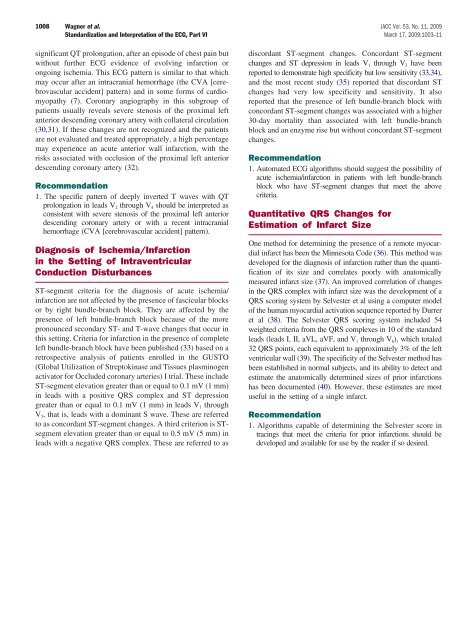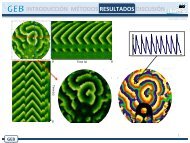1-s2.0-S0735109708041387-main
Create successful ePaper yourself
Turn your PDF publications into a flip-book with our unique Google optimized e-Paper software.
1008 Wagner et al. JACC Vol. 53, No. 11, 2009<br />
Standardization and Interpretation of the ECG, Part VI March 17, 2009:1003–11<br />
significant QT prolongation, after an episode of chest pain but<br />
without further ECG evidence of evolving infarction or<br />
ongoing ischemia. This ECG pattern is similar to that which<br />
may occur after an intracranial hemorrhage (the CVA [cerebrovascular<br />
accident] pattern) and in some forms of cardiomyopathy<br />
(7). Coronary angiography in this subgroup of<br />
patients usually reveals severe stenosis of the proximal left<br />
anterior descending coronary artery with collateral circulation<br />
(30,31). If these changes are not recognized and the patients<br />
are not evaluated and treated appropriately, a high percentage<br />
may experience an acute anterior wall infarction, with the<br />
risks associated with occlusion of the proximal left anterior<br />
descending coronary artery (32).<br />
Recommendation<br />
1. The specific pattern of deeply inverted T waves with QT<br />
prolongation in leads V 2 through V 4 should be interpreted as<br />
consistent with severe stenosis of the proximal left anterior<br />
descending coronary artery or with a recent intracranial<br />
hemorrhage (CVA [cerebrovascular accident] pattern).<br />
Diagnosis of Ischemia/Infarction<br />
in the Setting of Intraventricular<br />
Conduction Disturbances<br />
ST-segment criteria for the diagnosis of acute ischemia/<br />
infarction are not affected by the presence of fascicular blocks<br />
or by right bundle-branch block. They are affected by the<br />
presence of left bundle-branch block because of the more<br />
pronounced secondary ST- and T-wave changes that occur in<br />
this setting. Criteria for infarction in the presence of complete<br />
left bundle-branch block have been published (33) based on a<br />
retrospective analysis of patients enrolled in the GUSTO<br />
(Global Utilization of Streptokinase and Tissues plasminogen<br />
activator for Occluded coronary arteries) I trial. These include<br />
ST-segment elevation greater than or equal to 0.1 mV (1 mm)<br />
in leads with a positive QRS complex and ST depression<br />
greater than or equal to 0.1 mV (1 mm) in leads V 1 through<br />
V 3 , that is, leads with a dominant S wave. These are referred<br />
to as concordant ST-segment changes. A third criterion is STsegment<br />
elevation greater than or equal to 0.5 mV (5 mm) in<br />
leads with a negative QRS complex. These are referred to as<br />
discordant ST-segment changes. Concordant ST-segment<br />
changes and ST depression in leads V 1 through V 3 have been<br />
reported to demonstrate high specificity but low sensitivity (33,34),<br />
and the most recent study (35) reported that discordant ST<br />
changes had very low specificity and sensitivity. It also<br />
reported that the presence of left bundle-branch block with<br />
concordant ST-segment changes was associated with a higher<br />
30-day mortality than associated with left bundle-branch<br />
block and an enzyme rise but without concordant ST-segment<br />
changes.<br />
Recommendation<br />
1. Automated ECG algorithms should suggest the possibility of<br />
acute ischemia/infarction in patients with left bundle-branch<br />
block who have ST-segment changes that meet the above<br />
criteria.<br />
Quantitative QRS Changes for<br />
Estimation of Infarct Size<br />
One method for determining the presence of a remote myocardial<br />
infarct has been the Minnesota Code (36). This method was<br />
developed for the diagnosis of infarction rather than the quantification<br />
of its size and correlates poorly with anatomically<br />
measured infarct size (37). An improved correlation of changes<br />
in the QRS complex with infarct size was the development of a<br />
QRS scoring system by Selvester et al using a computer model<br />
of the human myocardial activation sequence reported by Durrer<br />
et al (38). The Selvester QRS scoring system included 54<br />
weighted criteria from the QRS complexes in 10 of the standard<br />
leads (leads I, II, aVL, aVF, and V 1 through V 6 ), which totaled<br />
32 QRS points, each equivalent to approximately 3% of the left<br />
ventricular wall (39). The specificity of the Selvester method has<br />
been established in normal subjects, and its ability to detect and<br />
estimate the anatomically determined sizes of prior infarctions<br />
has been documented (40). However, these estimates are most<br />
useful in the setting of a single infarct.<br />
Recommendation<br />
1. Algorithms capable of determining the Selvester score in<br />
tracings that meet the criteria for prior infarctions should be<br />
developed and available for use by the reader if so desired.



